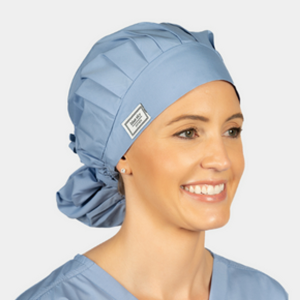
In the highly competitive world of healthcare, where cleanliness and precision are essential, every detail of the medical attire worn by healthcare professionals plays an important function in preventing infections. The hats worn by surgeons, which are often an overlooked part of the surgical outfit, have a variety of functions in creating a safe environment. This extensive exploration explores why wearing surgical hats prevents infection and protects health staff and patients. Read more for more info!
A Barrier Against Contamination
The Surgical Hat plays a crucial function in containing hair and is vital protection against contamination in clean environments like operating rooms. Human bodies naturally shed skin and hair; if not properly contained, they can be sources of infection in surgical processes. The Surgical Hats prevent hair from falling on the surgical site, thus reducing the possibility of introducing foreign particles that could cause infection.
Maintaining Sterile Fields
Making and maintaining a clean area is essential during surgical procedures to limit the chance of developing postoperative infections. Surgical hats aid in this by blocking hair and other substances from entering the surgical area. Any break in the sterile environment increases the risk of infection. The hats of a surgeon act as a first line of defense, protecting the security of the operating area.
Preventing Cross-Contamination
Healthcare professionals frequently travel between various areas within a healthcare facility, ranging from operating rooms to patient wards and areas of diagnostics. These hats can serve as a precaution against cross-contamination by ensuring that contaminants in one location, such as an unsterile environment for patients, are not transferred into the sterile surgical environment. This is especially important in limiting the chance of infection at the surgical site, which could have grave effects on patient outcomes.
Controlling the shedding of skin flake
Alongside hair, Human bodies naturally shed skin flakes. While they may appear not noticeable, they may contain microorganisms that could threaten infections. Covering hair and the head helps control the shedding of skin flakes. In limiting releases of the particles to the area, they have a crucial role in keeping a clean and safe working area.
Promoting professionalism and uniformity
Beyond their function, surgical hats are a part of the quality and professionalism of healthcare attire. Standardizing surgical hats gives healthcare professionals an organized and visually appealing appearance, emphasizing hygiene and infection prevention. A professional and consistent appearance creates a high-quality culture in patient care and adheres to strict standards for safety.
The Containment and Management of Bodily Fluids
The process of undergoing surgery often involves the exposure of bodily fluids such as blood and other infectious substances. The Surgical hats, which cover the head and hair, provide an additional barrier against accidental discharge of body fluids. This is crucial to safeguard health professionals involved in the procedure while reducing the chance of exposure to pathogens that can cause infection. Click here for details!
Focus and Comfort for Healthcare Professionals
Wearing surgical hats can help improve the general comfort and concentration of medical specialists during procedures. By firmly covering the hair, surgical hats can prevent distractions due to loose hair slipping into the eye or causing interference with the task. This increased concentration improves the efficiency of procedures and lowers the chance of making mistakes that could jeopardize patient safety.
Respect for Aseptic Techniques
The Surgical Hat is an essential part of aseptic procedures as it is a method that aims to create a sterile environment during surgical procedures. Aseptic practices are vital to avoid infections. Surgical helmets play an essential part in this process. By covering hair and following aseptic guidelines, health professionals help create a culture of paying attention to detail when preventing infections.
Infection Control in Various Healthcare Settings
Although surgical hats are typically used in surgical rooms, their importance can be found in various healthcare settings beyond surgery. In settings where infection control is essential, like hospitals, intensive care facilities, and isolation Wards, healthcare workers often wear hats made of surgical material to reduce the risk of getting sick. The widespread wearing of surgical hats demonstrates their significance for infection control across various healthcare settings.
Patient perception and trust
The presence of healthcare professionals sporting surgical hats conveys their dedication to infection control and the safety of patients. Patients frequently associate using sterile clothing, such as surgical hats, with elevated care and professionalism. The trust that comes from the apparent respect for infection control procedures can improve patients’ overall experience and perception of the facility’s healthcare.
Conformity to Industry Regulations
In the field of healthcare, compliance with regulations and standards is essential. Numerous healthcare accreditation bodies and regulatory bodies require that healthcare professionals wear specific clothing, such as surgical hats, to ensure that standards for infection control are maintained. Healthcare professionals and facilities must adhere to these guidelines to ensure the highest degree of security and quality of patient care.
The Design is undergoing a continuous evolution as well as Materials:
The advancements in medical apparel technology have resulted in the constant development of designs for surgical hats and materials. The latest surgical hats are typically constructed from breathable, lightweight, and moisture-wicking materials that address comfort issues without compromising the effectiveness of infection control. Including cutting-edge materials means that healthcare professionals comply with infection control protocols and experience greater ease of use during long procedures.
Flexibility to various roles in healthcare
The hats for surgical procedures are not only worn by surgeons. They are used by healthcare professionals who play a variety of capacities, such as nurses, anesthesiologists, and surgical technicians. This flexibility ensures a uniform approach to controlling infection among surgeons. No matter the specific medical function, using surgical hats is an effective method for ensuring safe environments.
Conclusion
Wearing surgical hats isn’t just a formality for healthcare clothes; it’s an essential practice rooted in infection control practices. From securing hair and limiting the release of contaminants to creating a clean environment and preventing cross-contamination, caps provide various protection against infection.

